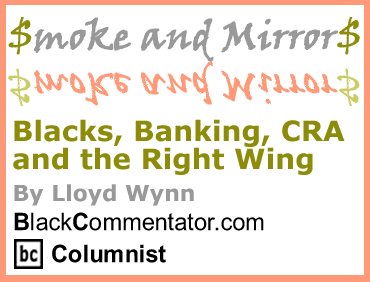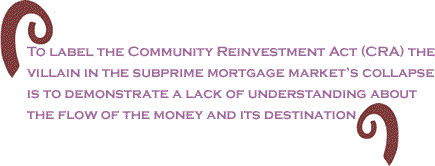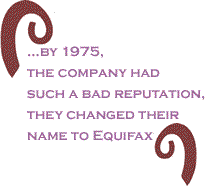
|
|||||||||||||||||||||||

|
|

Custom Search
|
|
 |
|
While Blacks have many individual superstars in diverse segments of our society, one of the fundamental weaknesses as a group is too many blind-spots when it comes to the economy. Those blind-spots, in part, will explain the disturbing trend of Blacks parroting rhetoric without considering its origin or veracity. To label the Community Reinvestment Act (CRA) the villain in the subprime mortgage market’s collapse is to demonstrate a lack of understanding about the flow of the money and its destination. Perhaps if we were better informed of the sequence of events and the parties involved in the originate-distribute business model used by Wall Street, we could challenge the purveyors of misinformation, Larry Kudlow, CNBC; Thomas DiLorenzo, Mises Institute; and Rep. Ron Paul, D. TX, for making these outrageous claims.
Hopefully what follows will offer some clarity to a very confused situation. 1. Investment banks (Goldman Sachs, J.P. Morgan Chase, Merrill Lynch, Bear Stearns, and Lehman Brothers) are the most complicit. The investment banks adopted the business model of origination to distribution. Investment banks developed the underwriting guidelines for approving mortgage loans (Option ARM, State Income, IO, NINJA, NIVA, No Doc, Lite Doc, etc.). Investment banks purchased mortgage loans from lenders. Investment banks constructed mortgage loans into securities (private label securitization) to provide readily available cash to lenders for more mortgage loans. Investment banks sold the securities/bonds to investors. 2. Rating agencies (Standard & Poors, Moody’s and Fitch) contributed to the meltdown by assigning the credit ratings to the tranches within the securities, see Recession: Federal Reserve Issuing Welfare Checks Discount Window. The investors (institutional and private) relied on the ratings to make decisions about their investment. Ratings are typically assigned from “junk to investment grade” with various levels in between that will determine how revenues and losses are assigned. Rating agencies collected their fees from the investment banks for assigning ratings. 3. Bond insurers (Ambac, FGIC, SCA, MBIA, etc.) provide insurance for bondholders in the event of a default. Insurers use their ratings to guarantee lowly rated private or non-agency bonds (for an explanation, see Let’s Get Our Heads Out of the Sand II). Investors purchase insurance to protect their investment if the underlying asset of the bond experiences a credit event. Investment banks facilitated transactions by establishing the underwriting guidelines, providing money for approved loans, securitizing loan pools and setting the proper environment for investors. The banks within the ambit of the CRA had a very minor role in the investment banks’ originate-to-distribute model for the following reasons: 1. Greater than 50% of subprime loans were originated by non-depository institutions (mortgage banker/broker conduit). 2. During the robust years of CRA enforcement 1993-98, according to the Fordham Urban Law Journal, there was a tremendous surge in lending to low-to-moderate income borrowers. CRA-covered institutions accounted for eighty-three percent of the growth in prime loans to these borrowers. In contrast, CRA-covered institutions were responsible for only fifteen percent of the increase in subprime loans during the same period. Subprime lenders not covered by CRA accounted for two-thirds of the increase in subprime mortgages. 3. The CRA was substantially weakened as the subprime market exploded. Since 2000, less than 2% of banks examined for compliance with the CRA have failed. Referrals to the Justice Dept. for legal action have been almost non-existent. During the Clinton Administration, 12% of banks examined, failed to comply with the CRA and the Justice Dept. took legal action against at least 25 of the referrals. In 2005 the Office of Thrift Supervision, Federal Reserve and Office of Comptroller of Currency, relaxed the dollar threshold, excluding smaller and medium sized banks from coming within the purview of the CRA.
At times I question whether this is idiocy (Right Wing rhetoric) but a sober thought reminds me this is a continuation of the shot that was fired at Ft. Sumter. To understand why the CRA does not factor into the collapse of this economy, one has to understand the history of banking and Black America since the Great Depression through 1968. As history is unappealing to so many of us, I will attempt to abbreviate or condense what I am about to share with you.
The
Atlanta Retail Credit Company employed the “Welcome Wagon” to go
into neighborhoods in the Credit
is the mother’s milk of this society and the evolution of credit
tells a very poignant story of Black history that has been omitted
from BlackCommentator.com Columnist, Lloyd Wynn, was a consultant in the secondary market. Lloyd is the author of Residential Real Estate Finance: From Application Through Settlement. Click here to contact Lloyd Wynn. |
|
Any BlackCommentator.com article may be re-printed so long as it is re-printed in its entirety and full credit given to the author and www.BlackCommentator.com. If the re-print is on the Internet we additionally request a link back to the original piece on our Website. Your comments are always welcome. eMail re-print notice
If you send us an eMail message we may publish all or part of it, unless you tell us it is not for publication. You may also request that we withhold your name. Thank you very much for your readership. |
|
| |
|
| October 9, 2008 Issue 294 |
|
| Executive Editor: Bill Fletcher, Jr. |
| Managing Editor: Nancy Littlefield |
| Publisher: Peter Gamble |
| Est. April 5, 2002 |
Printer Friendly Version
in resizeable plain
text format or pdf
format. |
| Frequently Asked Questions |
 |

|
 |
 |
 |
| |
| |





























 UCLA
Law Professor, Stephen Bainbridge comment
UCLA
Law Professor, Stephen Bainbridge comment

 The
first national consumer credit program was started in 1856 by Edward
Clark and Issac Singer. They sold sewing machines for $125 with
a $5 down payment and $3 per month. That was the birth of installment
sales on a national level. In 1872 Aaron Montgomery Ward started
the largest mail order business in the world and in 1899, Guy and
Cator Woolford started the Atlanta Retail Credit Company (Woolford
is still a prominent name in Atlanta, Thomas Woolford Trust, SunBank
and Cater Woolford Gardens).
The
first national consumer credit program was started in 1856 by Edward
Clark and Issac Singer. They sold sewing machines for $125 with
a $5 down payment and $3 per month. That was the birth of installment
sales on a national level. In 1872 Aaron Montgomery Ward started
the largest mail order business in the world and in 1899, Guy and
Cator Woolford started the Atlanta Retail Credit Company (Woolford
is still a prominent name in Atlanta, Thomas Woolford Trust, SunBank
and Cater Woolford Gardens).




